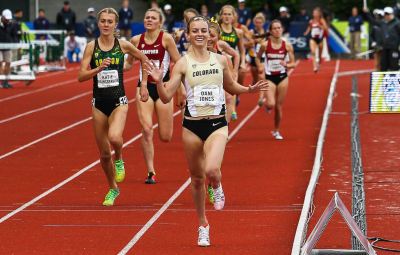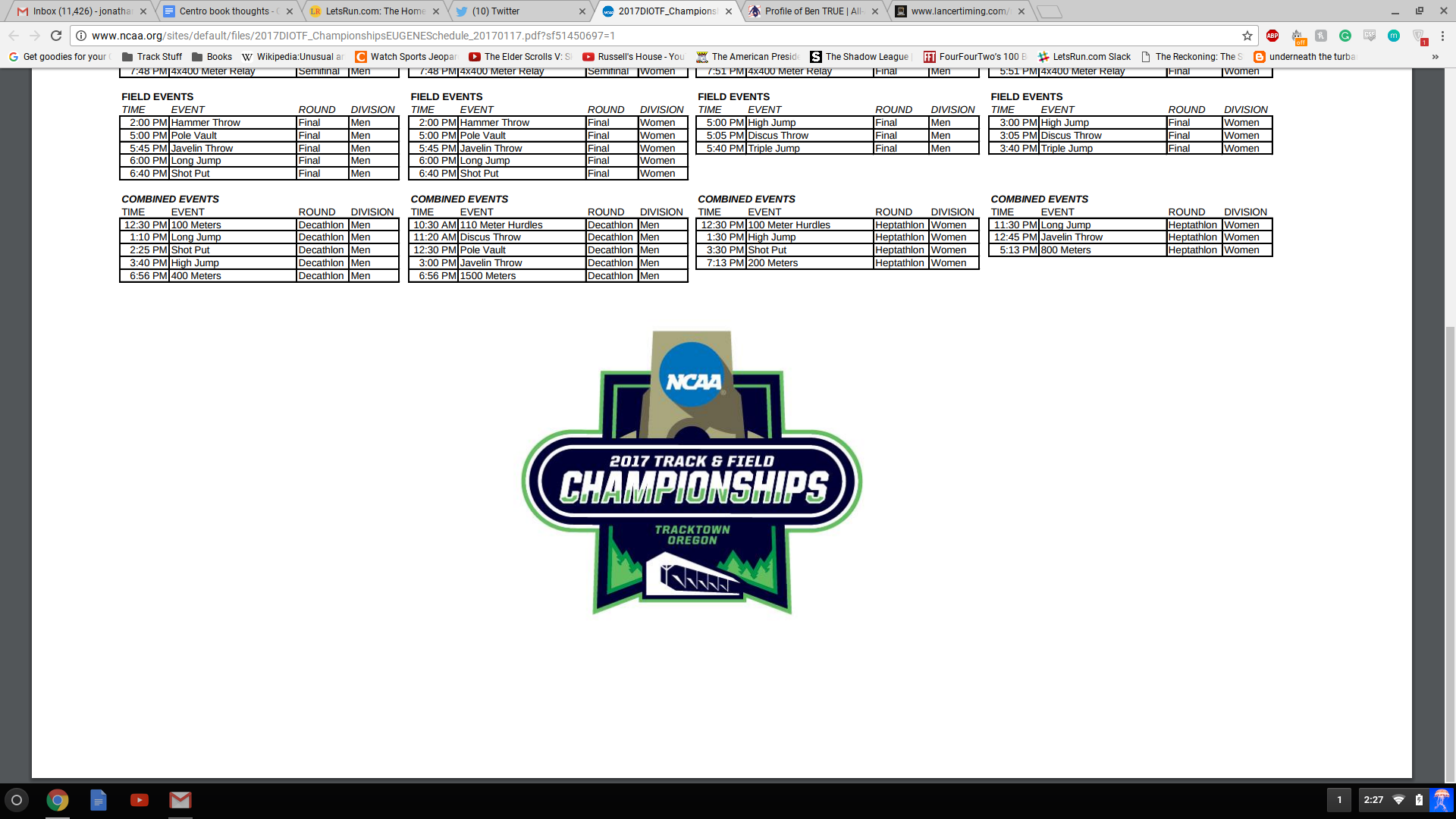The Fan’s Guide to 2017 NCAA Women’s Outdoor Track and Field Champs: Oregon Looks to Complete an Unprecedented Triple Crown
By LetsRun.com
June 5, 2017
The NCAA Outdoor Track & Field Championships is annually one of the best track meets on U.S. soil. Because the vast majority of U.S. Olympians (not to mention countless Olympians from other countries) come through the NCAA system, it’s a chance to see the stars of tomorrow break out. Or in the case of an exceptional talent such as Texas A&M 400-meter runner Fred Kerley, it’s the chance to see the stars of today.
Once again, the meet — which runs Wednesday through Saturday and will be held at Hayward Field in Eugene, Oregon, for the fifth year in a row — is loaded with talent, and we’ll be on-site in Eugene all week providing coverage. And while all U.S. track fans should watch the NCAAs, we know it’s quite possible that you haven’t been following the collegiate action all season. That’s where we come in. Below, we’ve prepared a fan’s guide to the meet where we give you the scoop on all the top events and athletes to watch. Watching track is much more fun when you know what to watch for, so do yourself a favor and read this preview. The women’s preview appears below and we give you five storylines to follow.
If you missed our men’s preview, you can read that here: LRC The Fan’s Guide to 2017 NCAA Men’s Outdoor Track and Field Champs: The Athletes & Races You Need to Know This Week Edward Cheserek has abdicated the throne as the biggest star of college track but there are a ton of big talents that are ready to take over – Christian Coleman, Fred Kerley, Emmanuel Korir, Lindon Victor, etc. We give you the 6 best storylines of the meet and get you ready for the Josh Kerr vs. Craig Engels battle at 1500 and Justyn Knight vs. Grant Fisher battle at 5000.
Schedule/results * TV/streaming information * Women’s entries * Men’s preview
1. Deajah Stevens looks to become the second straight Oregon Duck to pull off the sprint double
A year ago, if you told us that in 2017 an Oregon sprinter would be in position to win the 100 and 200 at NCAAs, we wouldn’t have been surprised. After all, Ariana Washington did just that as a freshman last year (and her other teammate Hannah Cunliffe won the 100 and 200 at Pac 12s). Yet even though Washington is seeded in the top five in each event at NCAAs, she’s not the most likely Duck to do it in 2017 (Cunliffe was injured at Regionals and didn’t make it to Eugene). That would be her teammate, Olympic 200-meter finalist Deajah Stevens, who hasn’t lost a 100 or 200 all year (she’s 3-0 against Washington this year outdoors). Stevens ran a stellar 22.09 200 at Pac-12s (#2 all-time NCAA and #1 at low altitude) and won the 100 there as well in 11.05 (her PR is 11.00, though she ran 10.89 at regionals with a 2.9 wind).
Assuming she doesn’t step out of her lane (as she did in the prelims at NCAA indoors), Washington is a lock in the 200, her specialty event. Stevens is more vulnerable in the 100 as LSU’s Aleia Hobbs ran 10.85, the #2 NCAA time ever (and best at low altitude), at the SEC Relays in April and hasn’t lost since. 2016 runner-up Ashley Henderson of San Diego State (wind-legal 11.01 at regionals) and, of course, Washington, should be threats as well.
But Stevens has the crowd on her side, and will be eager to make up for her DQ at NCAA indoors.
2. A loaded, wide-open 1500
The last two NCAA women’s 1500 finals have had three things in common. Both years, a woman from Mississippi State won the race. Both years, the winning time was fast. And both years, the finish was incredible. In 2015, Rhianwedd Price caught defending champ Shelby Houlihan of Arizona State by surprise and nipped her at the line to win in 4:09.56. Last year, Stanford’s Elise Cranny almost did the same thing to Marta Freitas, who began celebrating early, but fell short by just one-hundredth of a second as Freitas won in 4:09.53.
While it will be a tough ask for this year’s race to match the drama of the last two years, we could see more than just two women battling it out in 2017 as this field is stacked. Heading into NCAAs, five women have broken 4:12 this year; for comparison, from 2014-2016 combined, only four women managed that before NCAAs.
Karisa Nelson of Samford, the shock NCAA mile champion indoors, is the favorite on paper as she enters with the fastest time on the season at 4:10.91. But Washington’s Amy-Eloise Neale (4:11.02) is right behind, as is Dartmouth’s Helen Schlactenhaufen (4:11.15), who PR’d by an incredible seven seconds at regionals to make it to NCAAs (Schlactenhaufen isn’t even the Ivy League champ – that would be Yale’s Frances Schmiede). Notre Dame’s Jessica Harris also ran a big PR of almost five seconds (4:11.67) to win her heat at regionals, though that was less surprising given she split 4:27 on the anchor leg in the NCAA DMR in March.
 Jones picked up a pair of wins in her last trip to Eugene at Pac-12s (courtesy Colorado Track & XC)
Jones picked up a pair of wins in her last trip to Eugene at Pac-12s (courtesy Colorado Track & XC)
Price returns after missing last year with illness, though she hasn’t been close to her 2015 form — she was only 4th at SECs and only made it to NCAAs as the final time qualifier out of the East. Plus there’s 2016 NCAA mile champ Kaela Edwards of Oklahoma State, Oregon superfrosh Katie Rainsberger (4th NCAA XC, 3rd NCAA 3k) and Stanford superfrosh Christina Aragon, who was the bronze medallist at the World U20 champs last year and has the fastest PR in the field at 4:08.71 (though she has yet to win a 1500 this spring).
All of these women are incredible, but we don’t think any of them will win on Saturday. Instead, our pick is Colorado’s Dani Jones. Jones, only a sophomore, burst onto the scene by anchoring Colorado to the win in the DMR at NCAA indoors and returning the next night to win the 3k, both times with monster kicks. A monster kick is just about the best tool you can have as a 1500 runner, and Jones’ was on display once again at the Pac-12 meet where she won both the 1500 and the 5k in the country’s most loaded distance conference (Rainsberger and Neale were among her victims in both races). Any of the women we’ve mentioned have a chance to win, but Jones has been on fire the last three months and we expect that to continue at NCAAs. If she wins against this field, expect the Jenny Simpson comparisons to commence which may be unfair as Barringer ran 3:59 in college.
3. The return of Allie Ostrander
Ostrander was a freshman sensation last year at Boise State, finishing second at NCAA XC and bouncing back from injury to make the final in the 5,000 at the Olympic Trials, running a PR of 15:24 to place 8th. Though she missed the entire XC and indoor seasons this year, she’s healthy now and the returns have been solid as she made it to NCAAs in both the steeplechase and the 5,000.
The steeple is a new event for Ostrander, but she has won both of her attempts at it so far and her 9:55 PR is #5 in this field. Because of the high level of competition at nationals, the top women all usually run significantly faster at NCAAs, so she should get under 9:50 in Eugene. That may not be enough, however, as New Hampshire’s Elinor Purrier (3rd last year, 2nd in indoor mile) has run 9:43 and is the prohibitive favorite.
Ostrander is also entered in the 5,000, but considering it comes just an hour and a half after the steeple final, we don’t expect much from her in that race. More than anything, it’s good to see Ostrander healthy and running again. Hopefully she can keep it that way after an injury-plagued first two years in Boise.
Just getting to the meet health is an accomplishment. The number of female distance stars that aren’t at this meet due to injury is staggering. Here are the biggest 3 casualties.
- Molly Seidel – Notre Dame – The 4-time NCAA champ only ran one race outdoors.
- Erin Finn – Michigan – The 4-time NCAA runner-up didn’t run outdoors.
- Elise Cranny – Stanford – The 2016 NCAA 1500 runner-up was running great (4:11 this year) but then didn’t run at Pac 12s due to injury and then didn’t make it out of the West Regional aonce she returned.
4. Collegiate record watch
There are several athletes who could break collegiate records in Eugene. Let’s run through them, one by one.
- Deajah Stevens, Oregon, 200: As we mentioned earlier, Stevens ran a low-altitude NCAA record of 22.09 at Pac-12s. The overall record is 22.04, run by LSU’s Dawn Sowell in Provo, Utah, in 1989. Stevens could get it at NCAAs. The weather isn’t looking great for the 200 final (high of 59 and thunderstorms in Eugene on Saturday) and she will already have the 100 final in her legs, but she was in the exact same situation (with similar weather) at Pac-12s and ran that 22.09.
- Raevyn Rogers, Oregon, 800: The 800 field is stacked this year, but Rogers has been a cut above ever since running 1:59.71 to win NCAAs as a freshman two years ago. Expect her to win handily again in 2017 (she won Pac-12s by 2.74 seconds!); the only question is whether she can lower her own collegiate record of 1:59.10 that she set at Mt. SAC in April.
- LSU, 4×100 relay: LSU currently shares the collegiate record with Oregon at 42.12, and though they won’t have the Ducks to push them (Oregon was DQ’d at regionals), the Tigers have a good chance to gain sole possession of the record (they’ve also run the #3 and #4 times in collegiate history this year).
- Keturah Orji, Georgia, triple jump: Orji set the American record of 14.71 meters (48-3) to take 4th at last summer’s Olympics, and while that feat will be tough to replicate, her collegiate record of 14.53 (47-8), set at NCAAs last year, is within reach.
- Raven Saunders, Ole Miss, shot put: Another woman on this list who already owns the record in question. Saunders, who like Orji, just missed a medal in Rio (she was 5th), has set collegiate records in her last two NCAA championship appearances, throwing 19.33 (63-5) outdoors last year and 19.56 (64-2.25, the longest throw in NCAA history, indoors or out) at NCAA indoors in March. However, she has competed only twice outdoors in 2017 and skipped SECs, which may suggest she’s not at 100%.
- Maggie Ewen, Arizona State, hammer: Ewen threw 72.71 (238-6) in March, then went even further with a 72.81 (238-10) toss in April. Those two marks stand up as the second- and third-farthest in NCAA history, with only Jenny Dahlgren of Georgia ahead of her on the all-time list at 72.94 (239-4) in 2007. With the win all but assured, Ewen will have six cracks at the record in Eugene.
5. Can Oregon become the first school to capture the women’s triple crown?
No women’s team has ever won NCAA titles in cross country, indoor track and outdoor track in the same academic year. Arkansas was the last men’s team to do it in 1998-99; the Razorbacks actually pulled it off five times under John McDonnell, including three straight years from 1992-1994. But the Oregon women are ⅔ of the way there, and it would be a big surprise if they didn’t complete the sweep at Hayward Field this weekend. Track & Field News’ form chart has the Ducks scoring 73, well clear of runner-up USC (51) and that’s without star sprinter Hannah Cunliffe, the NCAA 60-meter champion indoors who withdrew midway through regionals with an injury. The 4×100 team, which set the collegiate record this year, also failed to qualify after being DQ’d.
USC is projected to get second, and like Oregon, the Trojans lean heavily on their sprinters. Unlike the Ducks, however, USC doesn’t have much margin for error in those events as it only has two non-sprinters entered in the meet: shot putters Tanya Sapa and Brittany Mann. Neither are projected to score, but we should point out that Mann was 3rd at NCAA indoors and 5th at NCAA outdoors last year — for Oregon (she’s a transfer). The good news for the Trojans is that they’re going head to head with the Ducks in many events, so big performances from their top athletes (particularly Deanna Hill in the 100 and 200) could essentially count double as more points for the Trojans means fewer points for the Ducks.
SEC schools Arkansas (50 projected points) and Georgia (49) are also projected to be in the mix, with Arkansas leaning heavily on the pole vault (18 projected points) and heptathlon (17 projected points). For the Hogs to have a chance, those events have to go well, but they’ll still need to pick up points in their other events and hope Oregon loses a few.
Georgia finished as the runner-up indoors despite entering zero athletes in the running events. They’ll try to go one better in Eugene, even though they once again will only have field eventers entered. The good news is Georgia has essentially a guaranteed win in the triple jump (Keturah Orji) and is also projected to finish 1-2 in the high jump (Mady Fagan and Tatiana Gusin), and first in the heptathlon (Kendell Williams). But to spring the upset, the Bulldogs will need to pick up some unlikely points, perhaps starting with a double from Orji in the triple and long jumps.
Between Deajah Stevens, Raevyn Rogers and the 4×400, the Ducks should have the firepower to get it done. But losing Cunliffe and the 4×100 cut into their margin for error. Any more missteps, and things get very interesting.




